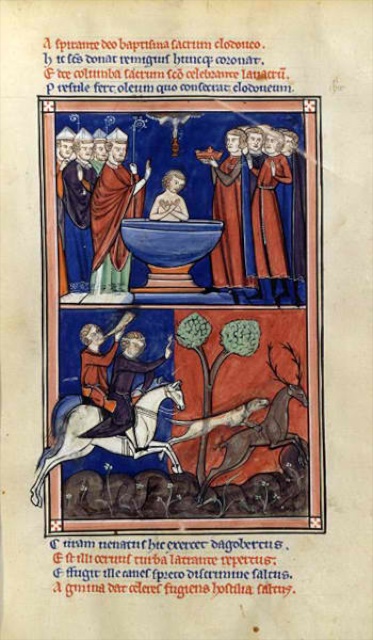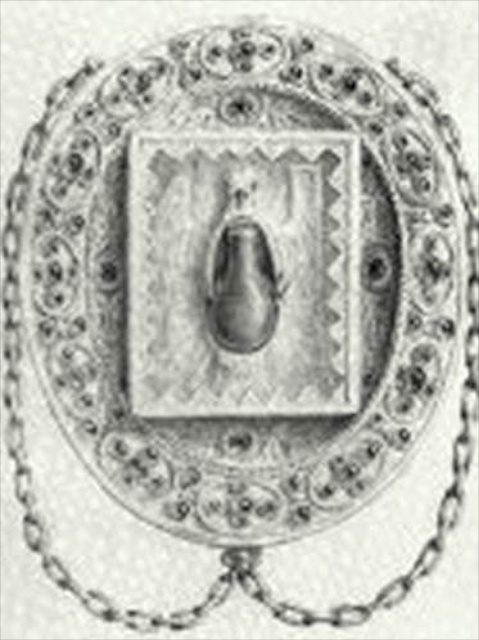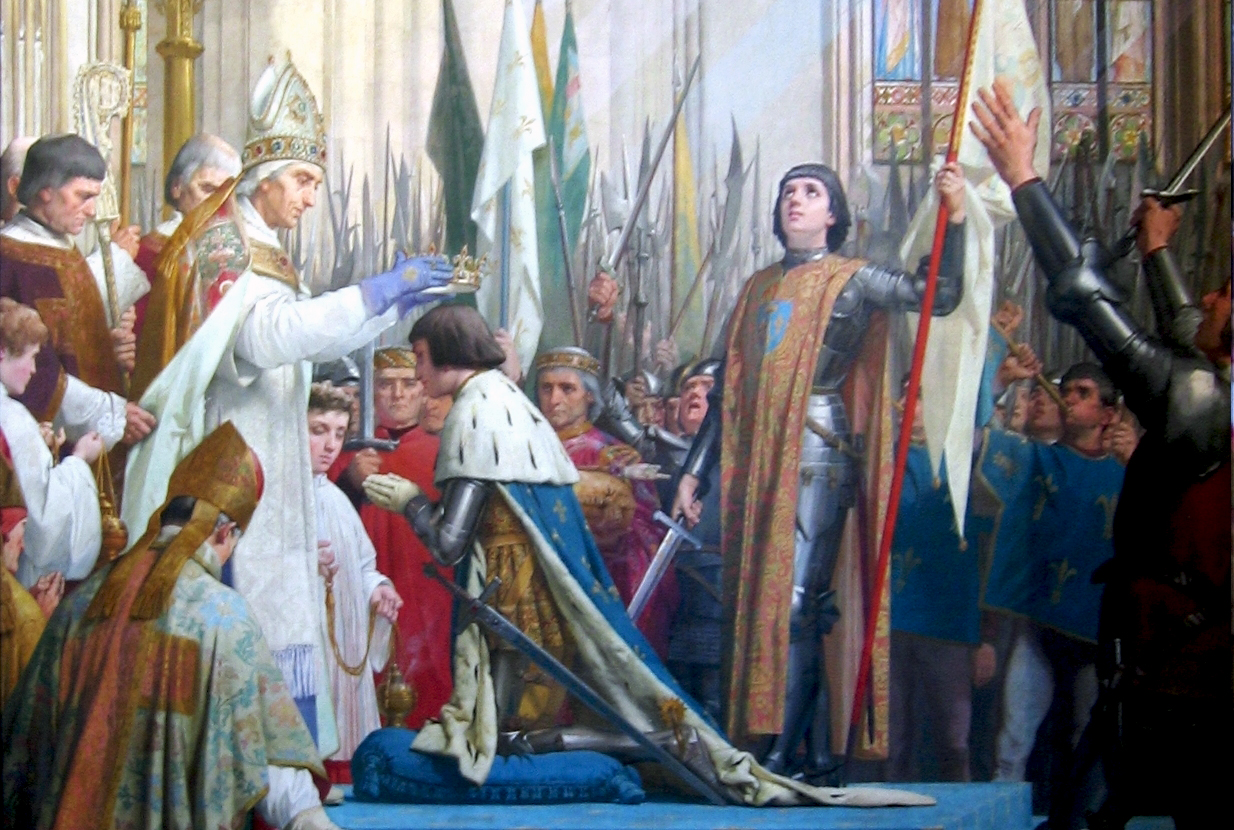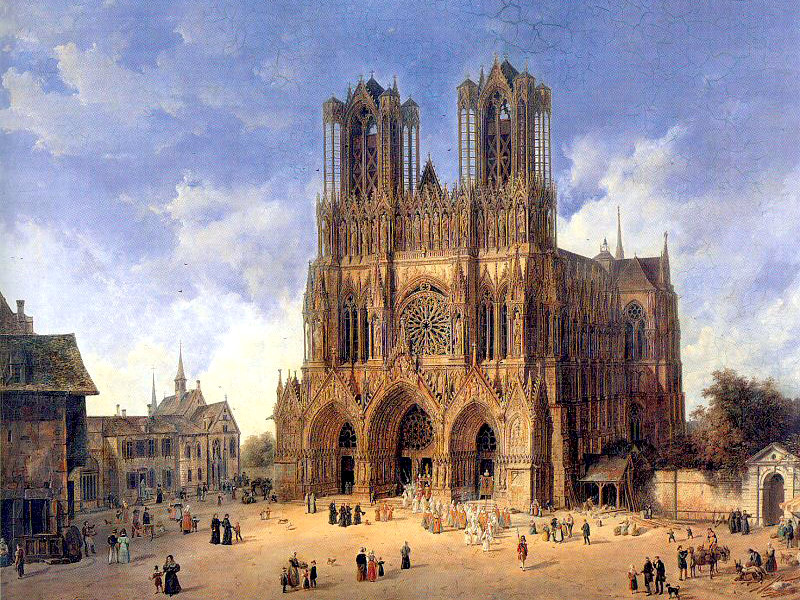The coronation of the Kings of France took place inside the Cathedral of Reims, a Gothic art masterpiece that has been listed as a UNESCO World Heritage Site since 1991.
The Origins of the Coronation of the Kings of France

In 498-499, the baptism of Clovis by St. Remi was the founding act of the Royal Anointing in Reims Cathedral. However, the first king to be crowned was Pepin the Short at Soissons in 751, then again at Saint-Denis in 754 by Pope Stephen II.
Reims Cathedral was not explicitly held in reference to the baptism of Clovis until Louis the Pious was crowned in 816 and an official document was given to Archbishop Ebbo by the emperor.
Nevertheless, the immediate successors of Louis the Pious did not follow in his footsteps, and it was not until the beginning of the 11th century that the cathedral imposed itself as the coronation site.
Crowned by the hands of archbishops
From then on, all the Kings of France were crowned in Reims by the hands of their archbishop, or at times by another prelate when the metropolitan seat was vacant. However, the coronations of Louis VI and Henri IV were held at Orleans Cathedral and Chartres Cathedral respectively, whereas Louis XVIII and Louis-Philippe were not crowned.
The coronation stems from the idea that there is no authority except God, according to the teachings of Apostle Paul:
“Non est enim potestas nisi a Deo, quæ autem sunt, a Deo ordinatæ sunt”, Romans 13:1.
Jurists and absolutist theorists, particularly under the Ancien Régime (Old Regime), did not agree with this at times. For some, the coronation does not make someone the king: he becomes one at the very second his predecessor dies. This follows the famous statement declared by the Chancellor of France:
“The King is dead. Long live the King!”
Joan of Arc in Reims
For others, the coronation bestows upon the sovereign his legitimacy. It was this belief that drove Joan of Arc to lead the heir to the throne (her “Gentil Dauphin”) to be crowned in Reims in 1429, despite the fact that Charles VII (1422-1461), residing in Bourges, was the de facto King for seven years already.
The Legend of the Holy Ampulla

Like the Kings of the Old Testament, the coronation was the sealed alliance between God and the Capetian sovereign: in exchange for divine anointing, the king promises to rule according to the law, to protect his peoples and to support religion.
This alliance took shape when the legend of the Holy Ampulla appeared in the 9th century.
It was in fact at the coronation of Charles the Bald in Metz that the Archbishop of Reims, Hincmar, recounted in his Vita Remigii, the miracle of the small vial brought to St. Remi by a dove that was sent from God for the anointing of Clovis.
From several traditions of Reims, Hincmar exaggerated the discovery of a vial in the tomb of St. Remi, containing herbs used to embalm the body of the prelate. Authenticated by Pope Innocent II in 1131 and entrusted to the care of the Abbey of St. Remi until the Revolution, the Holy Ampulla thus permanently assured Reims Cathedral the privilege of crowning the Kings of France.
During the French Revolution
During the French Revolution on October 7, 1793, in Reims (the present Place Royale), the Holy Ampulla was solemnly broken by the conformist Philippe Rühl, on the pedestal of the statue of Louis XV which was prior to that toppled, broken and meant to be delivered to a foundry for cannons.
However, a priest and a municipal officer took out what they could from the contents of the Holy Ampulla and hid it the day before. Moreover, two glass fragments of the vial, on which some of the balms remained, were secretly retrieved during the destruction of the reliquary. On March 22, 1825, the Archbishop of Reims proceeded to decant all these fragments into holy chrism, then into a new reliquary just in time for the coronation of Charles X. Today, the remains of the relic are preserved at the Palace of Tau, adjoining the cathedral.
The Ceremony of the Coronation of the Kings of France

Before 816, the ceremony firstly consisted of a simple anointing on the forehead of the sovereign, to which was added the crowning, the presentation of a sceptre and the oath to defend the Church (ordo of Hincmar). The ring and the sword appeared in the 10th century, followed by the dubbing of knighthood during the coronation of Philippe Auguste in 1179 and the oath against heretics at the beginning of the 13th century.
In the 14th century, the waking of the king and the procession from the palace of the archbishop to the cathedral were introduced in the coronation of Charles V in 1364.
Twenty-nine Kings of France were crowned at Reims between 1027 and 1825. Amongst them were Philippe Auguste, Louis IX, François I, Louis XIII, Louis XIV and Louis XVI.

More info about Reims Cathedral!
Here are a few websites and blogs about Reims Cathedral that you might find useful:
- on the blog: The coronation of the Kings of France in Reims
- the official website of the Cathedral of Reims [in French only]
- the website of the Reims Tourist Board
- the site of Centre des Monuments Historiques for climbing to the cathedral’s Towers.
- to book your accommodation in Reims, click on this affiliate link, which will redirect you to our partner
- Wikipedia’s article on Reims Cathedral
The cathedral is open every day from 7.30 am to 7.30 pm (7.15 pm on Sunday and celebration days). No visits on Sunday morning from 9 am-12 pm during masses. The entrance is free.
Things to do in Reims and Champagne
Looking for activities and things to do in Reims and the surrounding region of Champagne? Check out the offers from our partner Get Your Guide:
Inspired? Then pin it for later!




